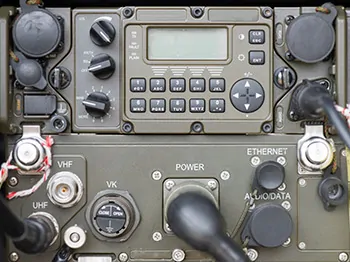Design of silicone keypads for hazardous or difficult situations

Keypads are used in places where the environmental conditions can affect the keypad integrity. I have listed here some of the main design factors that can be used to safeguard the keypad and the instrument it operates:
Flame resistance
Where necessary, the American UL-94 specifications are used. Most silicone rubbers will meet the grade UL-94-HB. In short, this specifies that the rubber (if ignited in a horizontal position) will self-extinguish quickly. Most silicone rubbers are inherently difficult to burn. A more stringent specification is UL-94-V1. At this level, the specification requires that the rubber when held in a vertical position will not carry on burning when ignited, nor will the embers carry on glowing for any time. This is a rough précis of the UL specification which goes into considerable detail on the test regime. If the UL-94-V1 level is required, it must be realised that this has implications for other physical properties, as the polymer has to be loaded with fire retardants.
Weather resistance
This generally resolves in resistance against either water ingress or ultraviolet light resistance. Water resistance is achieved by simply having a mechanical compression seal around the perimeter of keypad to stop water getting onto the contact area of the pc board. To make a compression seal, a perimeter bead of 0.5 mm radius around perimeter will compress and seal. Alternatively a raised bead could be added to the underside of the fascia.
If there is no fascia to seal against, sealing is probably best achieved by bonding the keypad to the pc board with double-sided adhesive.
The effects of ultraviolet light can cause discolouration of the pigments used in the silicone rubber and in the legend inks. The base polymer silicone has excellent resistance to UV light. If the keypad is going to be used outdoors, especially in sunnier climates like California, then this should be clearly noted on the drawing.
Electrical problems
If there is a risk to damage of electrical components by static, an anti-static grade of silicone should be specified as this will prevent a build up of charge. Making a keypad conductive is practical as the extra loading of conductive additive will degrade the physical properties.
Solvent or oil contamination
Generally speaking, silicone rubber does not resist continual contact with oils and solvents, and degradation can be expected, although there is no problem with usual alcohols. If solvent presence is unavoidable then other polymers should be considered over silicone. Effective against a lot of solvents is fluorosilicone rubber. This has the disadvantage as a keypad in that it cannot be printed upon. It is also very expensive. Some degree of solvent resistance is achieved by spraycoating the keypad with polyurethane or parylene coating. The parylene coating is an expensive process which can double the price of a silicone keypad.
Vandalism
I’ve heard that the worst situation for a silicone keypad is a control panel next to a first class seat on a long haul flight, where the passenger has plenty of time to fiddle! Keys can be prised out with fingernails or a biro. A solution to this problem is to protect the keys with a plastic or metal cap. Caps can be supplied as an assembly with the keypad, and can be designed captive under the fascia. If impact vandalism is to be guarded against, the keys which are capped should have travel limited by design. The pc board should be very robust or supported underneath by a metal plate. Unusual hazard I hope.
One situation we had to design for previously was for a keyboard used on a battlefield when a nuclear bomb explosion was to be predicted. The problem (only problem!)
was that the thermal flash would cause heat absorption by certain legend pigments and burn. The answer was to use colours and pigments that didn’t absorb heat so readily. I just hope the operator was as well heat-resistant.
These notes are intended only as aid memoir to show some of the problems and possible solutions. I am sure there are many more problems and situations with more ways to meet them yet to be devised.